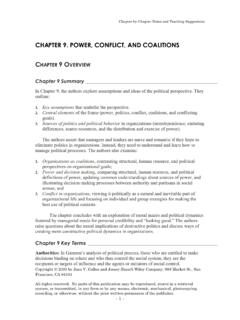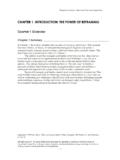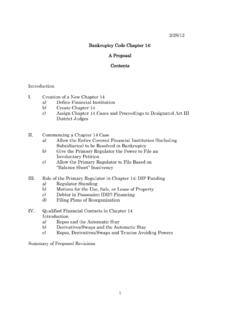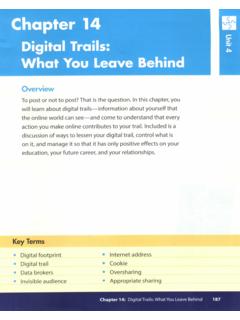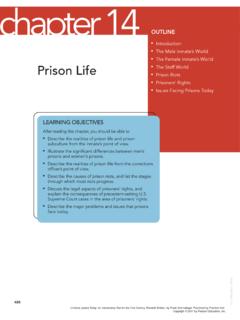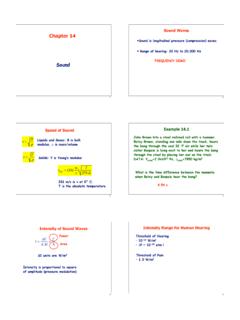Transcription of CHAPTER 14. ORGANIZATIONAL CULTURE IN …
1 CHAPTER -by- CHAPTER Notes and Teaching SuggestionsCopyright 2003 by Joan V. Gallos and Jossey-Bass/A Wiley Company, 989 Market St., San Francisco,CA 94103 All rights reserved. No parts of this publication may be reproduced, stored in a retrieval system, ortransmitted, in any form or by any means, electronic, mechanical, photocopying, recording, or otherwise,without the prior written permission of the 1 - CHAPTER 14. ORGANIZATIONAL CULTURE IN ACTIONCHAPTER 14 OVERVIEWC hapter 14 Summary_____Chapter 14 explores how leaders and managers can build a CULTURE that bonds a group inpursuit of a shared mission. The story of Data General s Eagle Group shows howinitiation rituals, specialized language, group stories, humor and play, and ceremoniescombine to transform a diverse collection of individuals into a spirited, high-functioningteam.
2 Tenets drawn from the Eagle Group s story include the following:1. How someone becomes a group member is Diversity is a team s competitive Example, not command, holds a team A specialized language fosters cohesion and Stories carry history and values while reinforcing group Humor and play reduce tension and encourage Ritual and ceremony lift spirits and reinforce Informal cultural players make contributions disproportionate to their formal Soul is the secret of 14 Major Case Examples_____ The Data General Eagle Group Air Force Ford Motor Company Mitsubishi Corporation SAS Outback SteakhouseSUGGESTIONS FOR TEACHING CHAPTER 14 The central ideas in CHAPTER 14 revolve around principles for building and shaping astrong group CULTURE .
3 Instructors can use this CHAPTER to:1. Explore groups from a symbolic Examine essential skills for building a positive Notes and Teaching SuggestionsCopyright 2003 by Joan V. Gallos and Jossey-Bass/A Wiley Company, 989 Market St., San Francisco,CA 94103 All rights reserved. No parts of this publication may be reproduced, stored in a retrieval system, ortransmitted, in any form or by any means, electronic, mechanical, photocopying, recording, or otherwise,without the prior written permission of the 2 -3. Scrutinize the strengths and limitations of the symbolic frame (since CHAPTER 14concludes the chapters examining this frame).Teaching methods appropriate for each approach are described in the sections that exercises keyed to the approaches appear in Student Exercises for CHAPTER 14, beginning on page 14: A Focus on a Symbolic Perspective on GroupsMuch of the literature on small groups comes from a human resource or socialpsychological perspective.
4 CHAPTER 14 can be used to broaden student understandingsabout small groups and to contrast structural, human resource, and symbolic prescriptionsfor effectiveness. This enables students to review small-group theory from Chapters 5and 8, as well as begin the process of integrating two 14: Cases Focusing on a Symbolic Perspective on GroupsDiscussion of the Eagle Group case as presented in CHAPTER 14 works well for comparingthe symbolic perspective with other perspectives. The CHAPTER is rich in description of theEagle Group s story, but instructors may want to assign Kidder s Soul of a New Machineas supplemental reading (a paperback version published by Little, Brown in 2000 isavailable).In large or small groups, students can discuss the ways in which the symbolicframe accounts for the Eagle Group s success and compare how human resource,structural, or political elements might also have contributed.
5 The structural characteristicsof high-performing teams outlined in CHAPTER 5, the human resource elements discussedin CHAPTER 8, and the characteristics of constructive politicians described in CHAPTER 10provide alternative ways of understanding what happened in the Eagle Group. This canlead into a discussion of the unique contributions of each frame and the overlap could add another case to work on these same issues, comparing thecase group with the Eagle Group. Possible cases include: The team videos from Workvideos discussed in the notes for CHAPTER 5 (ComputerEmergency Response Team, Chamber Music Quartet, Chinese String Quartet, andRowing in an 8; see CHAPTER 5: Films or Videos Focusing on UnderstandingStructure and Group Effectiveness ) are multiframe examples with rich material oncultural, as well as interpersonal and structural, issues in groups.
6 Since all the teamsportrayed are high-performance teams, they can be compared with the Eagle group toexamine how well the ideas in CHAPTER 14 transfer to other teams. Corning 1983-96: Transition at the Top (HBS 9-401-034) takes a multiyear look atthe evolution of a top management team and the relationship between team andorganizational Notes and Teaching SuggestionsCopyright 2003 by Joan V. Gallos and Jossey-Bass/A Wiley Company, 989 Market St., San Francisco,CA 94103 All rights reserved. No parts of this publication may be reproduced, stored in a retrieval system, ortransmitted, in any form or by any means, electronic, mechanical, photocopying, recording, or otherwise,without the prior written permission of the 3 - Acting Out of Character (HBS 9-414-012).
7 Acton Burnett (HBS 9-476-018). Claremont Instruments Co. (HBS 9-406-032). Meeting of the Overhead Reduction Task Force (HBS 9-478-013) and accompanyingvideo (HBS 9-884-002). London Symphony Orchestra (HBS 9-494-034). Slade Company (HBS 9-406-074). CHAPTER 14: A Focus on Essential Skills for CULTURE Building_____The Eagle Group case highlights skills needed for building strong and productivecultures. Instructors may want to use this CHAPTER to drill the ideas outlined in the text andto use the Eagle Group case to test student understanding of the core ideas. Ideas for skillbuilding in small groups are presented in Exercises and 14: A Focus on the Strengths and Limits of the SymbolicFrame_____Finally, instructors may want to use this CHAPTER as a jumping-off point for exploring thestrengths and limits of the symbolic frame.
8 Since this is often the most difficultperspective for students to grasp or appreciate, instructors can explore student responsesto symbolism before moving on to the integrative chapters. Symbolic issues can bediscussed in class or teams or woven into discussions of cases or films. (See the teachingnotes for Chapters 12 and 13 for suggestions of appropriate, frame-relevant cases andfilms.)STUDENT EXERCISES FOR CHAPTER 14 EXERCISE : Essential Skills for CULTURE BuildingIn courses with ongoing small groups, have students apply the prescriptions for shapingand building a productive CULTURE to the history and workings of their own teams. Groupsshould focus on both diagnosis (Where are we now? What is our CULTURE ? How is itChapter-by- CHAPTER Notes and Teaching SuggestionsCopyright 2003 by Joan V.)
9 Gallos and Jossey-Bass/A Wiley Company, 989 Market St., San Francisco,CA 94103 All rights reserved. No parts of this publication may be reproduced, stored in a retrieval system, ortransmitted, in any form or by any means, electronic, mechanical, photocopying, recording, or otherwise,without the prior written permission of the 4 -expressed? How is it reinforced?) and action planning (Where are we going? How couldwe strengthen our CULTURE to better support our mission? What, if anything, needs tochange?)EXERCISE : Essential Skills for CULTURE BuildingEither as a small-group activity or a written assignment, have students examine their pastexperiences in groups, briefly describing their best and worst group experiences.
10 Theycan then compare their descriptions of best and worst group experiences with the EagleGroup s experiences and the guidelines in the CHAPTER for productive groups.
